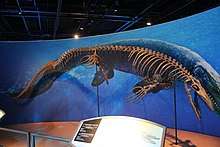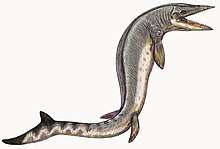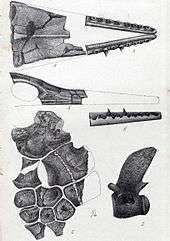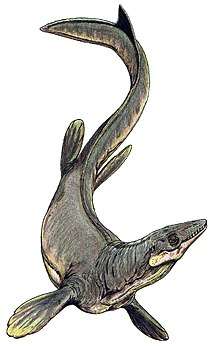Taniwhasaurus
Taniwhasaurus (from the Māori taniwha, a supernatural, aquatic creature, and the Greek σαυρος (sauros), meaning lizard) is an extinct genus of mosasaur (carnivorous marine lizards) which inhabited New Zealand, Japan and Antarctica.[1] The genus was a close relative of the genus Tylosaurus.
| Taniwhasaurus | |
|---|---|
 | |
| Reconstructed skeleton of T. antarcticus, Field Museum | |
| Scientific classification | |
| Kingdom: | Animalia |
| Phylum: | Chordata |
| Class: | Reptilia |
| Order: | Squamata |
| Superfamily: | †Mosasauroidea |
| Family: | †Mosasauridae |
| Subfamily: | †Tylosaurinae |
| Genus: | †Taniwhasaurus Hector, 1874 |
| Type species | |
| †Taniwhasaurus oweni Hector, 1874 | |
| Species | |
| |
| Synonyms | |
| |
Species


T. oweni
Taniwhasaurus oweni, the type species for Taniwhasaurus, was named and described by James Hector in 1874 from a fossil specimen found in the late Campanian Conway Formation outcrops at Haumuri Bluff, New Zealand (a stage known in the New Zealand geologic time scale as Haumurian). The skeletal material consisted of a skull, vertebrae, and paddles, which occurred in three separate sections but were thought to all belong to the same species.[2] Further cranial material and vertebrae were collected in 1999.[3] Tylosaurus haumuriensis, which was also named by Hector from the front parts of the jaws,[2] was found to be a junior taxon of T. oweni.[3]
T. capensis
Tylosaurus capensis was described in 1912 by Broom from Santonian deposits in Pondoland, South Africa based on a few fragmentary pieces of the jaw bone and a single vertebra. In 2019, a re-examination of tylosaurine taxa by Paulina Jimenez-Huidobro and Michael Caldwell of the University of Alberta found that the holotype specimen is more characteristic of Taniwhasaurus than Tylosaurus, but also found that the fossils were too poorly preserved to identify at the species and reidentified them as Taniwhasaurus indet. Nevertheless, the study also moved the taxon T. capensis to Taniwhasaurus.[4]
T. antarcticus
The genus Lakumasaurus was described in 2002 by Novas et al. from a fossil specimen found in the Santa Marta Formation of James Ross Island, Antarctica. When the type material was reexamined in 2007, James E. Martin and Marta Fernández determined Lakumasaurus to be a junior synonym of Taniwhasaurus and recombined the species Lakumasaurus antarcticus as T. antarcticus.[5]
T. mikasaensis
"Yezosaurus" was the name given to an undescribed genus of prehistoric marine reptile. Originally thought to be a Tyrannosaur dinosaur, it was later identified as a mosasaur or ichthyosaur which lived in what is now Japan.[6] The "type species", "Yezosaurus mikasaensis", was coined by Obata and Muramoto in 1977, but was not formally described until 2008, when the species T. mikasaensis was described by Caldwell et al (thereby making Y. mikasaensis a nomen nudum). Jimenez-Huidobro & Caldwell (2019) argued that there is not enough sufficient fossil evidence to distinguish between T. mikasaensis and T. oweni and thus reassigned the former to Taniwhasaurus indet.[4]
References
- Caldwell MW, Konishi T, Obata I, Muramoto K. 2008. New species of Taniwhasaurus (Mosasauridae, Tylosaurinae) from the upper Santonian-lower Campanian (Upper Cretaceous) of Hokkaido, Japan. Journal of Vertebrate Paleontology 28 (2): 339-348.
- Hector, James (1874). "On the fossil Reptilia of New Zealand". Transactions and Proceedings of the Royal Society of New Zealand. 6: 333–358.
- Caldwell, Michael W.; Holmes, Robert; Bell, Gorden L.,Jr.; Wiffen, Joan (2005). "An unusual tylosaurine mosasaur from New Zealand: A new skull of Taniwhasaurus oweni (Lower Haumurian: Upper Cretaceous)". Journal of Vertebrate Paleontology. 25 (2): 393–401.
- Paulina Jiménez-Huidobro; Michael W. Caldwell (2019). "A New Hypothesis of the Phylogenetic Relationships of the Tylosaurinae (Squamata: Mosasauroidea)" (PDF). Frontiers in Earth Science. 7 (47). doi:10.3389/feart.2019.00047.
- Martin, J.E.; Fernández, M. (2007). "The synonymy of the Late Cretaceous mosasaur (Squamata) genus Lakumasaurus from Antarctica with Taniwhasaurus from New Zealand and its bearing upon faunal similarity within the Weddellian Province". Geological Journal. 42 (2): 203–211. doi:10.1002/gj.1066.
- Yezosaurus in the Dinosaur Encyclopaedia at Dino Russ's Lair
| Wikispecies has information related to Taniwhasaurus |
